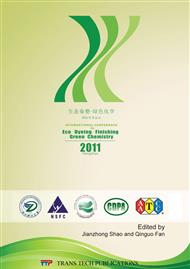p.320
p.326
p.332
p.337
p.342
p.346
p.351
p.356
p.360
Applying Syntan to Improve the Solid Effect of Silk/Wool Blends Dyed with Acid Dyes
Abstract:
Silk is blended with wool to make high-class apparel, contributing luster and strength. For the dyeing of silk/wool blends, the solid shades are usually required. However, the apparent color strength of dyed wool is generally higher than that of silk, which must be improved through the selection of dyes employed as well as the control of pH and dyeing temperature. In this paper, a novel approach of syntan application to improving the solid effect of silk/wool blends dyed with acid dyes was investigated. The influence of syntan on the distribution of different acid dyes in silk and wool as well as the apparent color strength of two fibers was determined. The mechanism for syntan to improve the solid effect was discussed according to the behaviors of syntan adsorption on silk and wool as well as fiber structures.
Info:
Periodical:
Pages:
342-345
Citation:
Online since:
January 2012
Authors:
Keywords:
Price:
Сopyright:
© 2012 Trans Tech Publications Ltd. All Rights Reserved
Share:
Citation:


